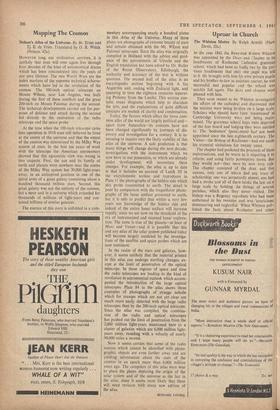Mapping The Cosmos
HOWEVER long our civilisation survives, it is unlikely that man will ever again live through four decades of the kind of astronomical drama which has been concentrated into the years of our own lifetime. The two World Wars are the index markers of the supreme technical achieve- ments which have led to the revelation of the cosmos The 100-inch optical telescope on Mount Wilson, near Los Angeles, was built during the first of these conflicts and the great 200-inch on Mount Palomar during the second. The technical developments carried out for pur- poses of defence and attack during the second led directly to the realisation of the radio telescope and the space probe At the time when the 100-inch telescope came into operation in 1918 man still believed he lived at the centre of the universe and that the extent of the cosmos was determined by the Milky Way system of stars. In the first ten years of work with the telescope the American astronomers showed that this egocentric view was wrong in two respects. First, the sun and its family of earth and planets were nowhere near the centre of the Milky Way system but 30,000 light-years away, in an uninspired position in one of the spiral arms of a great galaxy containing about a hundred thousand million stars. Second, this great galaxy was not the entirety of the cosmos, but a mere unit in a universe which extended for thousands of millions of light-years and con- tained trillions of similar galaxies.
The essence of this story is unfolded in a com-
mentary accompanying nearly a hundred plates in this Atlas of the Universe. Many of these plates are photographs of extreme beauty of stars and nebula obtained with the Mt. Wilson and Palomar telescopes. Since the atlas was originally compiled in Holland with the advice and guid- ance of the astronomers of Utrecht and the English translation has been edited by Dr. Butler of the Royal Observatory, Edinburgh, the authority and accuracy of the text is without question. The second half of the atlas is an encyclopedic section beginning with A for Angstrom unit, ending, with Zodiacal light, and spanning in time the eighteen centuries separat- ing Ptolemy from the Luniks. This section con- tains many diagrams which help to elucidate the text, and the explanations of quite difficult concepts are models of clarity and condensation.
Today, the factors which affect the more com- mon atlas of the world are largely political and— apart from Antarctica—its contents have not been changed significantly by journeys of dis- covery and investigation for a century. It is in- teresting to inquire into the likely stability of this atlas of the universe. A safe prediction is that many things will change during the next decade; investigations with the instruments which we now have in our possession, or which are already under development, will necessitate these changes. For example, the atlas is up to date in that it includes an account of Lunik III in the encyclopedic section and reproduces in Plate 11 the photographs of the hidden side which this probe transmitted to earth. The detail is poor by comparison with the magnificent photo- graphs of the lunar surface presented to earth, but it is safe to predict that within a very few years our knowledge of the hidden side and indeed of the entire lunar surface will increase rapidly, since we are now on the threshold of the era of instrumented and manned lunar explora- tion. The same is true of the planets—at least of Mars and Venus—and it is possible that this and any atlas of the solar system published today will become largely outdated by the investiga- tions of the satellite and space probes which are now imminent.
In the realm of the stars and galaxies, how- ever, it seems unlikely that the material printed in this atlas can undergo startling changes, ex- cept at the limit of penetration of the optical telescope. In those regions of space and time the radio telescopes are leading to the kind of revolution in astronomical outlook which accom- panied the introduction of the large optical telescopes. Plate 84 in the atlas shows three examples of photographs of strange nebulae which for reasons which are not yet clear are much more easily detected with the large radio telescopes than by the 200-inch optical telescope. Since the atlas was compiled, the combina- tion of the radio and optical telescopes has pushed out the limit of penetration from the 2,000 million light-years mentioned here to a cluster of galaxies which are 6,000 million light- years away, receding with a velocity of nearly 90,000 miles a second.
Now it seems certain that some of the radio sources which cannot be identified with photo- graphic objects are even farther away and are yielding information about the state of the cosmos in an epoch more than 6,000 million years ago. The compilers of this atlas were wise to place the plates depicting the origin of the solar system and of the universe as the last in the atlas, since it seems most likely that these will need revision with every new edition of the atlas.
BERNARD LOVELL


































 Previous page
Previous page